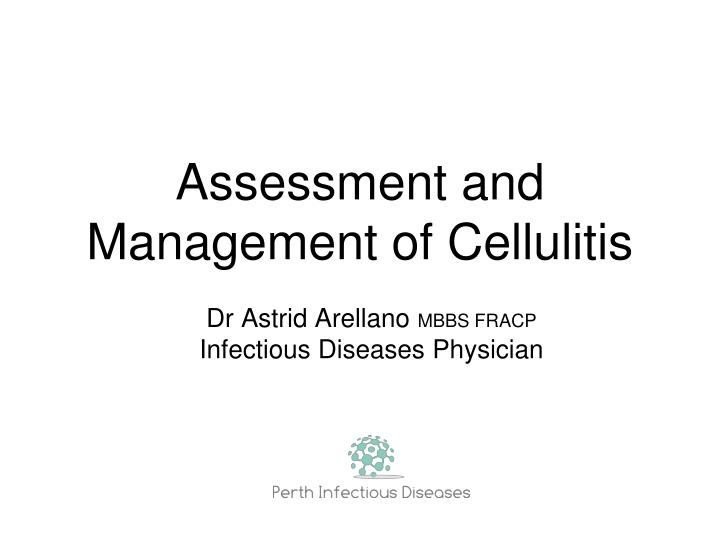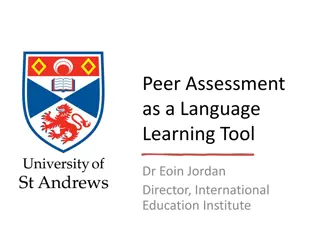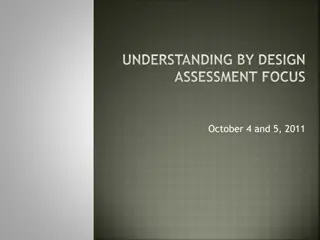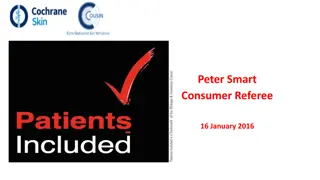Assessment and Management of Cellulitis by Dr. Astrid Arellano
Dr. Astrid Arellano, an Adult Infectious Diseases Physician based in Subiaco, discusses the definition, pathophysiology, clinical presentation, and red flags of cellulitis. Learn about the mimics of cellulitis and the critical condition of necrotizing fasciitis.
Download Presentation

Please find below an Image/Link to download the presentation.
The content on the website is provided AS IS for your information and personal use only. It may not be sold, licensed, or shared on other websites without obtaining consent from the author.If you encounter any issues during the download, it is possible that the publisher has removed the file from their server.
You are allowed to download the files provided on this website for personal or commercial use, subject to the condition that they are used lawfully. All files are the property of their respective owners.
The content on the website is provided AS IS for your information and personal use only. It may not be sold, licensed, or shared on other websites without obtaining consent from the author.
E N D
Presentation Transcript
Assessment and Management of Cellulitis Dr Astrid Arellano MBBS FRACP Infectious Diseases Physician
Adult Infectious Diseases Physician University of Adelaide Graduate, Advanced training in Perth, WA both in microbiology and infectious diseases Private Practice based in Subiaco Inpatient care at SJOG Subiaco Hospital Public Health Physician at WA TB Control Program Lecturer and Clinical Tutor at Notre Dame University 1/1 Sheen Street Subiaco WA 6008 PH: 6478 9963 FAX: 9389 6531 M: 0421514653
Cellulitis Definition Non-necrotising inflammation of the skin and subcutaneous tissues, usually caused by bacterial infection
Pathophysiology Acute inflammation with heat, swelling, redness and pain. Microscopically: inflammatory infiltrate, predominant neutrophils and fat necrosis Erysipelas is superficial (only dermis), cellulitis involves subcutaneous tissues Fig. 2 Eysipelas: high power H&E, dense inflammatory infiltrate Fig. 3 High power H&E, inflammation and fat necrosis Fig. 1 Eysipelas: low power H&E, inflammation Images from DermNet NZ: https://www.dermnetnz.org/topics/erysipelas-pathology/
Cellulitis Clinical Presentation Classic Erythema Pain Swelling Warmth Signs suggestive of severe infection: Malaise, chills, fever, and toxicity Lymphangitic spread (red lines streaking away from the area of infection) Circumferential cellulitis Pain disproportionate to examination findings
Cellulitis mimics Contact dermatitis Septic bursitis Gout Fig. 1 Chronic lymphoedema changes Acute and chronic lipodermatosclerosis (venous insufficiency) Lymphoedema BILATERAL cellulitis is rare Fig. 2 Venous insufficiency changes Images from DermNet NZ: https://www.dermnetnz.org/topics/erysipelas-pathology/
Cellulitis RED FLAGS Violaceous bullae Cutaneous hemorrhage Skin sloughing Rapid progression Gas in the tissue Systemic compromise: hypotension, tachycardia
Necrotizing fasciitis Life threatening emergency: skin, fat and muscle necrosis, polymicrobial, rapidly progressive with shock, extensive tissue loss and death
Pathogens Erysipelas: skin raised above surrounding normal skin, clear demarcation. Streptococcus pyogenes Common in infants, young children, older adults. Butterfly pattern of facial skin, and affecting lower limbs. Cellulitis: Involves deeper tissues Children: periorbital Adults: lower legs Rapidly spreading: Streptococcus pyogenes or other Streptococci e.g. group B, C, or G Trauma, ulceration: Staphylococcus aureus (cMRSA, 40% of S.aureus) Other organisms: Water related: Aeromonas spp., Vibrio spp. Immunocompromised: polymicrobial including Gram negatives, fungi and mycobacteria
Predisposing factors Damage to skin e.g. trauma, ulcers. Tinea infection Fissured dermatitis Lymphoedema History of DVT Vascular surgery Radiotherapy Insect bites/scabies
Diagnosis Clinical, no investigations required if: Limited skin involvement Minimal pain No systemic signs of illness (eg, fever, altered mental status, tachycardia, hypotension) No risk factors for serious illness (eg, extremes of age, co- morbidities immunocompromise)
Systemic signs= Investigations FBP, CRP, U+E Blood cultures: Moderate to severe disease (cellulitis complicating lymphoedema) Orbital Cellulitis (fat and eye muscles) and periorbital (eyelid) cellulitis Patients with malignancy or chemotherapy Neutropenia or severe cell-mediated immunodeficiency Animal bites
Hospital Admission Patients who have extensive cellulitis, especially if: Patients with systemic signs (high fever, chills, rigours, hypotension, tachycardia) Immunocompromised Diabetics Chronic renal failure patients Orbital cellulitis (involvement of fat and orbit muscles) +/- periorbital cellulitis
Treatment Mild: Streptococcus pyogenes, Staphylococcus aureus, use: Flucloxacillin 500mg (child 12.5mg/kg up to 500mg) QID orally for 5-10 days Non-immediate penicillin allergy: Cephalexin 500mg (child 12.5mg/kg up to 500mg) QID orally for 5-10 days Immediate penicillin allergy: Clindamycin 450mg (child 10mg/kg up to 450mg) TDS orally for 5-10 days Severe: Not improving after 48h or systemic symptoms
Treatment Severe cellulitis management: Streptococcus pyogenes, Staphylococcus aureus, use: Flucloxacillin 2g (child 50mg/kg up to 2g) IV QID Non-immediate penicillin allergy: Cefazolin 2g (child 50mg/kg up to 2g) IV TDS Immediate penicillin allergy: Vancomycin* or Clindamycin 600mg (child 15mg/kg up tp 600mg) IV TDS ***Ceftriaxone/broad spectrum antibiotics not required*** Therapeutic Guidelines Antibiotic, version 15, 2014
Hospital in the Home Administration of IV antibiotics in outpatient setting where IVABs are required for >1 week Once stable and select patients (independent, no significant co-morbidities), supported home environment, able to attend clinic reviews and blood testing. Antibiotic regimen: once daily dosing or infusion Requires log term IV line: PICC line Convenient for young/working individuals Nursing Service: Access via AMU, direct admit for adults SJOG Subiaco Hospital, ID Physicians and Health Choices Nurses
Cellulitis Take Home Messages Cellulitis is an infection of the skin and subcutaneous tissues, most common organisms involved are S.pyogenes and S.aureus RED FLAGS: systemic symptoms, rapid progression, gas in tissues, bullae, immunocompromised patient, orbital involvement Direct and fast admission to AMU at SJOG Subiaco Hospital for IVABs and HITH without ED waiting times, expert management and rapid return to work for patients Bilateral cellulitis is rare, more likely venous insufficiency changes























